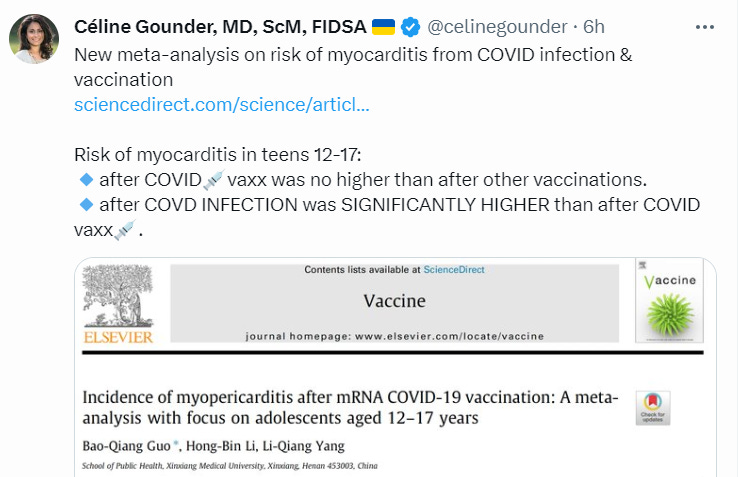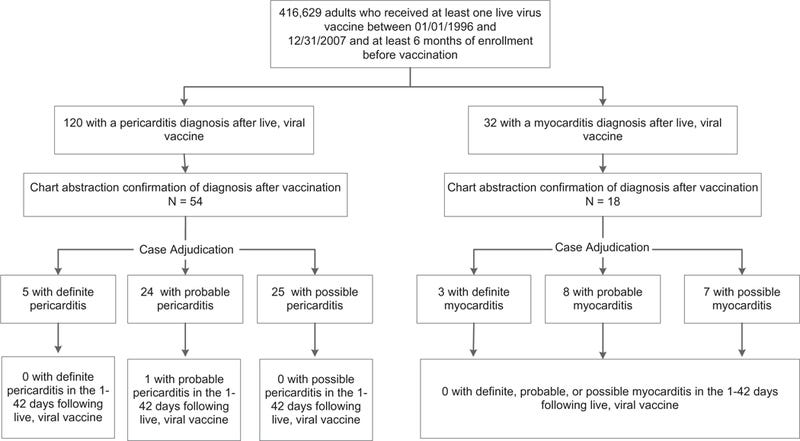More bad science minimizing myocarditis from the Covid vaccine
Celine Gounder shared a new flawed meta-analysis from Chinese researchers
I have several other articles I’m working on, but I wanted to take a few minutes to address a recent study shared uncritically today on Twitter by Celine Gounder. The flaws with this study are very obvious and very significant, and she should not have shared this without considering these serious weaknesses in the paper.
Dr. Walid Gellad, Professor of Medicine at University of Pittsburg and Director of the Center for Pharmaceutical Policy and Prescribing, first brought this paper to my attention, and he shared many of the same initial concerns that I did. When I looked into more in depth, I found additional errors with the underlying data that make it even more flawed than either of us originally suspected.
Combining Risks for Sex and Doses
The first problem with this study is that it does not look at the subgroup that is of specific concern for post-vax myocarditis from the Covid vaccine — young men after dose 2.
The study combines rates for males and females in their comparisons, even though it is well-known that the risk is MUCH higher in young men than in young women. Much like how they combined men and women, the study also combined risks from the first and second dose in their analysis. It’s also well-known that the risk is MUCH higher after the second dose.
The study authors acknowledge both of these uneven risks in their abstract:
“Myopericarditis was more common among males (66.0 [40.5–107.7] cases) than females (10.1 [6.0–17.0] cases) and among those receiving the second dose (60.4 [37.6–96.9] cases) than those receiving the first dose (16.6 [8.7–31.9] cases).”
However, for their analysis where they compare myocarditis after the Covid vaccine to other vaccines and to Covid infection, they use the combined rate of men and women after either dose, instead of looking at the subgroup of dose 2 for males, which is where the bulk of the myocarditis risk lies. This dilutes the risk of vaccine myocarditis substantially.
Drs. Benjamin Knudsen and Vinay Prasad have an excellent paper showing this effect of how vaccine myocarditis rates are diluted when you don’t stratify properly by sex, age, dose, and manufacturer.
This distinction about dose 2 is important, because the US could have opted to recommend only one dose to young men, substantially reducing their risk from vaccine-induced myocarditis from the Covid vaccine, or spaced out the doses more to reduce risk from dose 2, but the FDA and CDC chose not to do this.
Comparing Rates to Smallpox(!) Vaccination
In order to make their case, the authors compared their diluted risk of myocarditis from the Covid vaccine to the risk of myocarditis from the SMALLPOX vaccine. This vaccine is not commonly used and has well-known risks of myocarditis, so it’s a bizarre and unfair comparison. From another study on smallpox vaccine myocarditis, “Although myocarditis has been reported following many different vaccines, the smallpox vaccine has the strongest association.”
Considering that the Covid vaccine is often compared to the influenza vaccine in that it’s for a common respiratory pathogen that shares a similar level of risk to children, that seems like a much more appropriate comparison.
Here’s what the Lancet paper that they cite for the smallpox vaccination rates says:
The incidence of myopericarditis was 132·1 (81·3–214·6) per million doses of smallpox vaccine (p<0·0001 vs COVID-19 vaccines), 1·3 (0·0–884·1) per million doses of influenza vaccine (p=0·43), and 57·0 (1·1–3036·6) per million doses for studies reporting on a variety of vaccines (p=0·58; appendix p 23).
That’s 132.1 per million for the smallpox vaccine and 1.3 per million for the flu vaccine. I think it’s clear why a study that wants to minimize Covid vaccine myocarditis would compare to the smallpox vaccine. For comparison, the new study found, “The pooled incidences of myopericarditis after mRNA COVID-19 vaccination among adolescents aged 12–17 years were 43.5 (95 % CI, 30.8–61.6) cases per million vaccine doses for both BNT162b2 and mRNA-1273 (39 628 242 doses; 14 studies).”
Comparing Rates to Other Vaccinations
The study also compares their diluted rate of myocarditis from the Covid vaccine to “non-COVID-19 vaccinations (56.0 cases per million vaccine doses)” from the Lancet (the confidence interval is not listed in the recent paper, but is 10.7-293.7). However, this rate from the Lancet paper is still skewed heavily toward smallpox vaccination — 6 of the 11 studies are exclusively for smallpox vaccines, plus the Engler study described below, which was primarily of the smallpox vaccine and is an extreme outlier. The 4 non-smallpox vaccine studies (highlighted in the figure below) include the Kuntz study, also described below, in which the Lancet authors erroneously reported the number of myopericarditis cases.
As you can see from the figure above, the Engler study is so far out of line with every other study that it should have raised some red flags. It’s a small study from the military, with mostly young men (higher risk of myocarditis), and most (85%) of the vaccines given in the study were smallpox vaccinations.

Of the non-smallpox studies, the Kuntz study included two live virus vaccines not typically given in the US: the oral polio vaccine (OPV) and the yellow fever vaccine, so it is also not a good comparison to the Covid vaccine. In addition, the authors of the Lancet meta-analysis included all 152 instances of myocarditis or pericarditis from this study that were coded at any time in the medical records (including prior to vaccination). The 152 diagnoses were first narrowed down to 72 (54 pericarditis and 18 myocarditis), and Kuntz paper states that “the remaining 80 potential cases were excluded because they had miscoded or rule-out diagnoses, lacked sufficient information in the medical record to confirm the diagnosis, or were diagnosed prior to 1996” (when the vaccine study period began). The results were further adjudicated and narrowed down to only 1 case of probable pericarditis in the 42 days following vaccination, yet the Lancet authors included all 152 as cases in their meta-analysis.
Comparing Rates to “Covid-19 Infection”
Finally, this paper compares their diluted rate of myocarditis from Covid vaccination to the rate of myocarditis from Covid infection. For this, they use a very flawed MMWR as their source. The MMWR is based on electronic health records (EHR) to determine the rate of myocarditis after Covid infection. However, as you are surely aware, most young people did not go to the doctor or hospital when they got Covid, so their infections would not be recorded in any EHR. The vast majority of children just had a mild infection and recovered at home. Many did not even take a Covid test at all, much less through their healthcare system.
As a result, the rate that this paper shows for myocarditis after infection is skewed to only the sickest of young people, which greatly increases the rate of complications like myocarditis. Said another way, the rate of myocarditis in young people after a documented Covid infection at the doctor is MUCH higher than the rate of myocarditis in all young people after a Covid infection.
In addition, since the Covid vaccination doesn’t prevent you from getting Covid, you could get vaccinated and still have risk of myocarditis after Covid.
The CDC loves these studies that over simplify the data to promote vaccination and minimize harms. The CDC admits that content published in MMWR is the “official voice” of CDC and reflect CDC policy.
Conclusion
This latest meta-analysis is yet another paper designed almost exclusively to promote mRNA vaccination by severely minimizing the risk of myocarditis from the Covid vaccine. In addition to combining risks, it compounds factual errors from the Lancet paper that it heavily relies on for comparison data. It’s odd that it was done by researchers in China, where the mRNA Covid vaccines are not widely used.
Of course, it was picked up and spread widely by Celine Gounder, and has been widely retweeted by other Covid vaccine evangelists. These “experts” either didn’t evaluate the study to see if it was sound, or who didn’t care about the quality of the study because it promotes Covid vaccination in young people.
Finally, the paper concludes, “these findings provide an important context for health policy makers and parents with vaccination hesitancy to weight the risks and benefits of mRNA COVID-19 vaccination among adolescents aged 12–17 years.” One has to wonder what the point of promoting Covid vaccination in adolescents is now, considering there is widespread population immunity from prior infection, combined with their already low risk of severe Covid. When studies like this one use misleading data, they are not providing the “important context” on “risks and benefits” as they claim. Instead papers like this just add to suspicions that public health is irreparably compromised.
Correction 6/22/2023: I initially made an error in the section about the comparison to other vaccines. The recent study used a comparison to the “non-Covid vaccination” rate from the Lancet paper (56.0), and noted that they did NOT compare to the “non-smallpox vaccinations” rate from the same paper (57.0) — which I found contained a smallpox study. However, the “non-Covid vaccination” rate from the Lancet paper is primarily made up of studies on the smallpox vaccine, plus the flawed analysis of the Kuntz paper by the Lancet authors, so the comparison is still problematic.






When people talk about the corruption of science and medicine, this willful misrepresentation by Gounder et al is part of what they have in mind. It puts the mission of treating and curing people in the background by turning the vaccines, for example, into an ideological, politicized battlefield.
Thank you. I think a really key point is this one:
"In addition, since the Covid vaccination doesn’t prevent you from getting Covid, you could get vaccinated and still have risk of myocarditis after Covid."
I wonder about this a lot. Is there ANY study that can quantify whether and to what extent "covid after vaccination" leads to less myocarditis than covid after prior infection or, for arguments sake, covid before any exposure (even though ~no one left in this category, but of historical importance.) Seems like a critical data point for all the people who have a knee jerk reaction to this topic by saying "but covid myocarditis is worse."